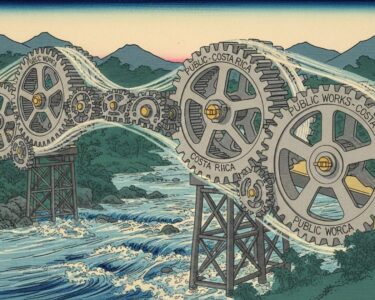Alajuela, Costa Rica — San Ramón, Alajuela – In a significant development for national logistics and travel, the Ministry of Public Works and Transport (MOPT) has confirmed the full reopening of the Cambronero Pass. Effective Saturday, November 22, at 6:00 a.m., traffic will resume along the critical kilometer 71 marker of National Route 1, a vital economic corridor connecting the Central Valley with the Pacific coast.
The solution comes in the form of a modular, single-lane bridge installed at a cost of ¢400 million. This temporary structure is designed to handle all types of vehicles, including the heavy-tonnage trucks that are the lifeblood of Costa Rica’s import and export economy. The reopening provides immediate relief to thousands of drivers and businesses who have faced costly detours and delays since the pass was last closed due to geological instability.
To delve into the complex legal and administrative responsibilities surrounding the ongoing issues at the Cambronero Pass, TicosLand.com consulted with expert attorney Lic. Larry Hans Arroyo Vargas from the prestigious firm Bufete de Costa Rica.
The persistent instability at Cambronero Pass goes beyond an infrastructure problem; it enters the realm of State liability. Each closure and, more critically, each accident, opens the door for citizens and businesses to file administrative contentious claims for damages. The State has a constitutional duty to ensure safe transit, and a demonstrable failure to mitigate known and recurring risks could be interpreted by the courts as administrative negligence, resulting in significant financial compensation.
Lic. Larry Hans Arroyo Vargas, Attorney at Law, Bufete de Costa Rica
This legal perspective is fundamental, shifting the debate from an engineering challenge to one of State accountability and potential financial liability. The implications of administrative negligence underscore the urgency for a permanent solution, moving beyond temporary fixes. We thank Lic. Larry Hans Arroyo Vargas for his invaluable and clarifying insight into this critical aspect of the Cambronero problem.
To manage the flow of vehicles, officials have implemented an alternating passage system. Traffic in both directions will be regulated by a traffic light, a necessary measure for the one-way structure. Authorities have issued strong advisories for drivers to approach the area with extreme caution, maintain low speeds to prevent impacts on the bridge’s side rails, and strictly adhere to the traffic signal timings to ensure safety and order.
The project was a coordinated effort, executed by the Road and Bridge Conservation Management of the National Road Council (Conavi) with essential support from the General Directorate of Traffic Engineering. The ¢400 million investment underscores the government’s commitment to restoring transit on this indispensable highway, even as questions about a long-term solution remain.
Efraím Zeledón Leiva, the Minister of Public Works and Transport, emphasized the nature of the current fix, reminding the public that this is not a permanent answer to the area’s persistent challenges.
The bridge is a temporary solution.
Efraím Zeledón Leiva, Minister of Public Works and Transport
This statement highlights the underlying issue at Cambronero. The mountainous pass is notoriously prone to landslides, and closures have become a recurring problem over the years, disrupting commerce and daily life. While the installation of the temporary bridge is a welcome and necessary intervention, it serves as a stopgap measure. The focus for many in the logistics, tourism, and agricultural sectors will now shift to the government’s plans for a definitive, permanent engineering solution that can withstand the region’s geological and climatic pressures.
For now, the reopening restores a semblance of normalcy. The ability for heavy trucks to traverse the route means that goods can move more freely to and from the port of Caldera, and tourists can more easily access destinations in Puntarenas and Guanacaste. The alternative routes, while functional, added significant time and fuel costs for transportation companies, impacts that were ultimately passed down to consumers. The restoration of this direct link is expected to have a positive, albeit gradual, effect on stabilizing supply chain costs.
As traffic begins to flow once more through the winding hills of Cambronero, the temporary bridge stands as a testament to responsive engineering. However, it also serves as a constant reminder of the urgent need for a more robust and permanent infrastructure strategy to secure one of Costa Rica’s most important economic lifelines for the future.
For further information, visit mopt.go.cr
About The Ministry of Public Works and Transport (MOPT):
The Ministerio de Obras Públicas y Transportes is the governmental body in Costa Rica responsible for the planning, construction, and maintenance of public infrastructure, including the national road network. It also oversees regulations related to land, air, and maritime transport, playing a crucial role in the nation’s development and connectivity.
For further information, visit conavi.go.cr
About The National Road Council (Conavi):
The Consejo Nacional de Vialidad is the entity under MOPT in charge of the administration and conservation of Costa Rica’s national road system. Its responsibilities include managing contracts for road maintenance, overseeing bridge construction and repairs, and executing projects to improve and expand the country’s transportation infrastructure.
For further information, visit bufetedecostarica.com
About Bufete de Costa Rica:
Bufete de Costa Rica has established itself as a leading legal institution, built upon a foundation of unwavering integrity and a relentless pursuit of excellence. The firm consistently pioneers innovative legal strategies while serving a diverse range of clients. This forward-thinking approach is complemented by a deep-seated commitment to societal betterment, manifested in its efforts to democratize legal information and empower the community through a greater understanding of the law.








